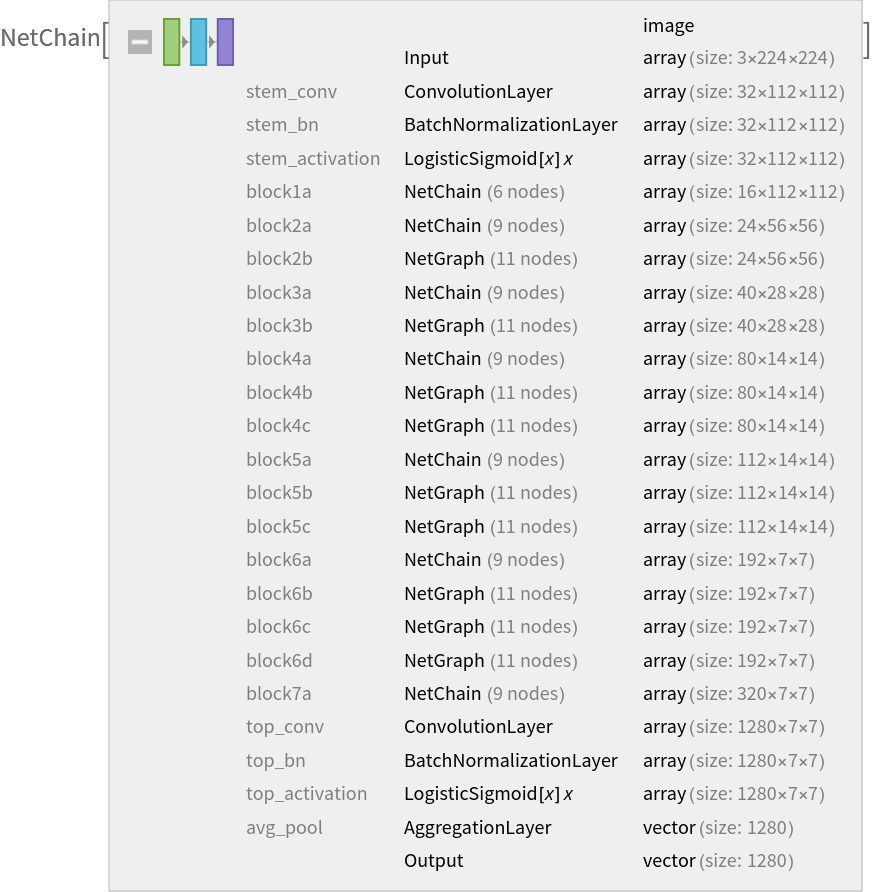Resource retrieval
Get the pre-trained net:
NetModel parameters
This model consists of a family of individual nets, each identified by a specific parameter combination. Inspect the available parameters:
Pick a non-default net by specifying the parameters:
Pick a default uninitialized net:
Basic usage
Classify an image:
The prediction is an Entity object, which can be queried:
Get a list of available properties for the predicted Entity:
Obtain the probabilities of the 10 most likely entities predicted by the net:
An object outside the list of the ImageIdentify Net classes will be misidentified:
Obtain the list of names of all available classes:
Feature extraction
Remove the last three layers of the trained net so that the net produces a vector representation of an image:
Get a set of images:
Visualize the features of the set of images:
Transfer learning
Use the pre-trained model to build a classifier for telling apart images of motorcycles and bicycles. Create a test set and a training set:
Remove the linear layer from the pre-trained net:
Create a new net composed of the pre-trained net followed by a linear layer and a softmax layer:
Train on the dataset, freezing all the weights except for those in the linearNew layer (use TargetDevice -> "GPU" for training on a GPU):
Perfect accuracy is obtained on the test set:
Net information
Inspect the number of parameters of all arrays in the net:
Obtain the total number of parameters:
Obtain the layer type counts:
Export to ONNX
Export the net to the ONNX format:
Get the size of the ONNX file:
Check some metadata of the ONNX model:
Import the model back into Wolfram Language. However, the NetEncoder and NetDecoder will be absent because they are not supported by ONNX:


![(* Evaluate this cell to get the example input *) CloudGet["https://www.wolframcloud.com/obj/315d9c51-6cf4-4811-814a-c1db3aaacab7"]](https://www.wolframcloud.com/obj/resourcesystem/images/fc0/fc014850-7e34-4f29-b0b3-f0669804cdb5/4af0a96760f92724.png)

![(* Evaluate this cell to get the example input *) CloudGet["https://www.wolframcloud.com/obj/cdab1fc8-82c3-4921-8eca-ede5b1ebea1c"]](https://www.wolframcloud.com/obj/resourcesystem/images/fc0/fc014850-7e34-4f29-b0b3-f0669804cdb5/5d2c20688793f4ef.png)

![(* Evaluate this cell to get the example input *) CloudGet["https://www.wolframcloud.com/obj/9a321a08-abb3-450f-b576-376b8c00da5b"]](https://www.wolframcloud.com/obj/resourcesystem/images/fc0/fc014850-7e34-4f29-b0b3-f0669804cdb5/1b34c942d8edac1e.png)
![EntityValue[
NetExtract[NetModel["Wolfram ImageIdentify Net V2"], "Output"][[
"Labels"]], "Name"] // Short](https://www.wolframcloud.com/obj/resourcesystem/images/fc0/fc014850-7e34-4f29-b0b3-f0669804cdb5/514bdb6f52e96665.png)
![(* Evaluate this cell to get the example input *) CloudGet["https://www.wolframcloud.com/obj/39378fac-b708-4bf8-8620-9c24f5003a71"]](https://www.wolframcloud.com/obj/resourcesystem/images/fc0/fc014850-7e34-4f29-b0b3-f0669804cdb5/4e1203425f060795.png)

![(* Evaluate this cell to get the example input *) CloudGet["https://www.wolframcloud.com/obj/d0541ad4-c743-41d0-a1fe-baaf9fe18d0e"]](https://www.wolframcloud.com/obj/resourcesystem/images/fc0/fc014850-7e34-4f29-b0b3-f0669804cdb5/7d82f22b969052a6.png)
![(* Evaluate this cell to get the example input *) CloudGet["https://www.wolframcloud.com/obj/df4f93f4-e0b6-479f-ba2a-56cd69ba5fcc"]](https://www.wolframcloud.com/obj/resourcesystem/images/fc0/fc014850-7e34-4f29-b0b3-f0669804cdb5/4f5f5b78594a2ba0.png)

![newNet = NetChain[<|"pretrainedNet" -> tempNet, "linearNew" -> LinearLayer[], "softmax" -> SoftmaxLayer[]|>, "Output" -> NetDecoder[{"Class", {"bicycle", "motorcycle", "dog", "cat"}}]]](https://www.wolframcloud.com/obj/resourcesystem/images/fc0/fc014850-7e34-4f29-b0b3-f0669804cdb5/61eeddc950450b56.png)
![onnxFile = Export[FileNameJoin[{$TemporaryDirectory, "net.onnx"}], NetModel["Wolfram ImageIdentify Net V2"]]](https://www.wolframcloud.com/obj/resourcesystem/images/fc0/fc014850-7e34-4f29-b0b3-f0669804cdb5/4e45447dc7c378a4.png)